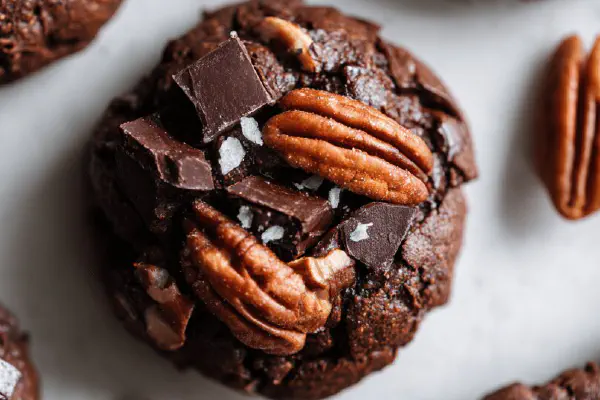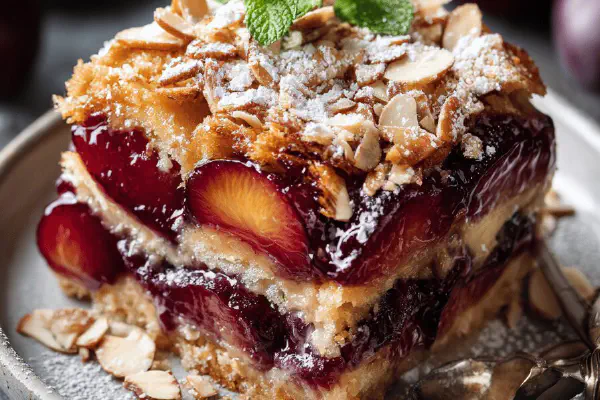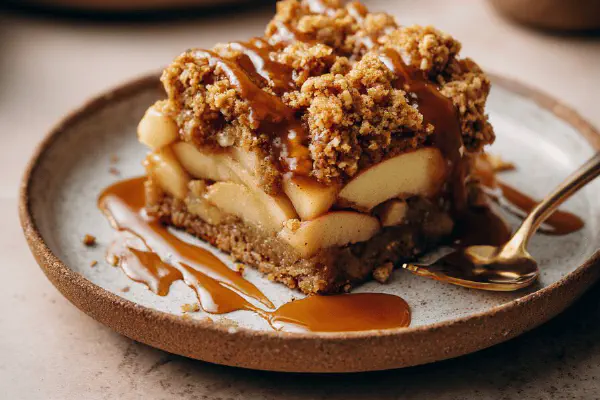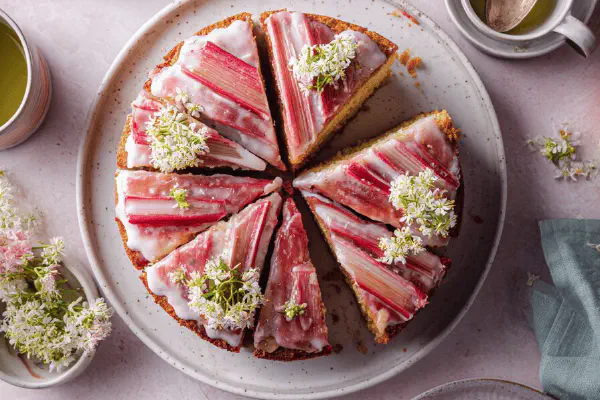Raspberry Lemon Tart Remix

By Emma
Certified Culinary Professional
Ingredients
Crust
- 220 ml (1 cup) all-purpose flour, unbleached
- 10 ml (2 tsp) sugar
- 2 ml (1/3 tsp) salt
- 115 ml (1/2 cup) coconut oil, solid, cut into cubes (sub for butter)
- 1 egg
- 20 ml (1 1/3 tbsp) fresh lemon juice
- 2.5 ml (1/2 tsp) vanilla extract
Filling
- 100 ml (7 tbsp) sugar
- 15 ml (1 tbsp) arrowroot powder (sub for cornstarch)
- 150 ml (2/3 cup) raspberry jam
- 110 ml (1/2 cup minus 1 tbsp) fresh lemon juice
- 4 eggs
- 110 ml (1/2 cup minus 1 tbsp) butter, diced
Whipped topping
- 125 ml (1/2 cup) canned coconut cream, chilled
- 25 ml (1 1/2 tbsp) sugar
- Fresh raspberries for garnish (optional)
About the ingredients
Method
Crust
- Pulse flour, sugar, and salt in food processor till mixed. Add coconut oil cubes, pulse in bursts until mixture looks like coarse crumbs. Stop before melting oil; bits still visible.
- Add egg, lemon juice, vanilla; pulse until dough starts gathering. If too dry, drop cold water tbsp by tbsp, just enough for dough to hold together—not sticky.
- Dust counter. Press dough into rough rectangle with hands, very lightly knead just a few times—not overworking. Roll to about 3 mm (1/8 inch) thickness.
- Transfer carefully onto rectangular removable bottom pan, about 33 x 10 cm (13.5 x 4 inches). Dock bottom with fork holes—keeps bubbles away.
- Chill crust minimum 30 min in fridge to solidify fats—prevents shrinking during baking. Meanwhile, put oven rack low-mid position and preheat oven to 200°C (400°F).
- Bake crust ~17 minutes, edges light golden, center feels set but not dark. Remove, cool 5 min.
- Reduce oven heat to 190°C (375°F).
Filling
- In medium saucepan, combine sugar and arrowroot, whisk dry to mix. Add jam, lemon juice, eggs, butter chunks immediately—do not let eggs scramble before heat.
- Cook over medium heat. Stir steadily, whisk scraping bottom to avoid lumps.
- Liquid thickens and gleams; starts bubbling gently—not slapping pan. This took me approx. 9 minutes.
- Strain mixture through fine sieve into bowl for ultra-smooth texture. Pour hot filling into warm crust.
- Return tart to oven. Bake ~8-10 minutes until filling looks set but a little wobbly in center—don’t wait for full solidity or cracks will form.
- Cool 15 min on counter, then refrigerate at least 3 hours till fully chilled and slices clean easily.
Whipped topping
- Pour cold coconut cream and sugar into chilled bowl.
- Whip with hand or stand mixer till firm peaks form. Should hold shape when lifted but not grainy or buttery.
- Pipe or dollop whipped topping generously over chilled tart.
- Garnish with fresh raspberries or any fresh berries you like. I add tiny mint leaves sometimes for pop of green—makes it look like you really tried.
- Serve tarte bien froid.
Tips and tricks
- Coconut oil solid at room temp varies by room weather; keep chilled for easier work.
- If crust cracks while rolling, just press pat and seal with fingers; no need to reroll and risk toughening.
- Arrowroot binds clearer than cornstarch and tolerates acidic lemon juice better, so filling looks glossy and not cloudy.
- Don’t overbake filling; it’ll firm off in fridge. Overcooked leads to cracked, rubbery surface. Timing depends—use visual cues not timer slavishly.
- Whip coconut cream same temp as fridge. Warm cream never whips well.
- Jam—chunky or smooth—adds texture contrast. Feel free to use homemade or tart raspberry preserves for extra fruit punch.
- Don’t skip docking crust! Bubbles burst make ugly tall spots or holes.
- Leftover crust dough? Roll, chill, cut into thin cookies dusted with cinnamon-sugar. Bake 10 min. Bonus snack.
- If no fresh raspberries, try thin slices of kiwi, strawberries, or edible flowers to brighten.
- Oven temps vary; watch crust colors rather than clock. Golden edges signal done.
- If filling is too runny after first chill, 15 min extra fridge or thin gelatine layer atop keeps it firm.
- Whipped coconut cream might weep if stored too long. Whip just before service; keep tart cooled until then.
Cooking tips
Chef's notes
- 💡 Coconut oil crust needs chilling to stay workable—warm kitchen wrecks texture instantly. Pulse flour, sugar, salt, then cold cubes coconut oil. Stop pulsing before it melts—should look like coarse crumbs. Press lightly not overwork or dough toughens. Dock crust before blind baking—no bubbles or weird crust rises. Baking crust till edges golden signals fat solidifying but center still soft; cool slightly before filling.
- 💡 Arrowroot powder beats cornstarch with acidic citrus—filling stays shiny, not cloudy. Mix sugar and arrowroot dry first to avoid clumps. Add eggs and butter fast before heat hits to prevent scrambled lumps. Cook on medium heat steady stirring, whisk scraping bottom to keep smooth. Filling ready when glossy shimmer appears and small bubbles slowly rise. Don’t rush or bubbles slap pan; lasts around nine minutes usually.
- 💡 Whip coconut cream chilled thoroughly—warm cream fails every time. Use thick top layer only, no watery liquid. Whip in chilled bowl, dry surfaces only. Peaks should hold shape but stay light, no graininess or butterfat forming. Pipe or dollop immediately to avoid weeping later. Store tart chilled, topping waits till last minute for freshest hold. Coconut cream adds richness without dairy tang—keep whip timing tight.
- 💡 Watch visual cues not timers. Crust edges golden, not dark. Filling sets but jiggles slightly in center—that wobble means done. Overbake filling and you get cracks or rubbery surfaces, frustrating. Cool tart on counter before fridge to avoid cracking thermal shock. Leftover dough rolls thin, bakes to cinnamon-sugar cookies—snack bonus. Fresh raspberries best garnish but substitute kiwi, strawberries, or edible flowers for color pop.
- 💡 Partial lemon juice replaced by orange juice softens sharp citrus bite—expect slightly lighter filling color. Arrowroot tolerates acids better; thinner gel layer atop filling can rescue runny texture after chill. Dock crust holes mandatory. Coconut oil fat structure different from butter; keeps crust tender but requires careful keeping cold. Don’t skip rest times. Oven temps vary, watch colors closely not minutes.
Common questions
Why swap butter for coconut oil?
Coconut oil changes crust texture, more tender but melts differently. Keep dough cold or risk greasy mess. Flavor slightly nutty too. If room warm, chill slices between pulses in processor to keep cold. Butter crust shorter chill okay but coconut oil needs patience.
How to avoid lumps in filling?
Mix arrowroot with sugar dry, add eggs and butter before heat fast. Stir constantly medium heat. Whisk bottom edges while cooking. Strain after cooking optional but smooths texture lots. Avoid letting eggs scramble—heat slowly, steady whisking.
Filling cracks after baking?
Overbake main cause. Filling sets fully chilled, not in oven. Pull tart when filling jiggles slightly. Cool on counter first before fridge to reduce thermal shock. Thin gelatine layer helps fix too-runny filling after chill.
Can whipped coconut cream be prepped early?
Chill canned cream overnight minimum. Whip only top thick layer. Store whipped topping chilled but avoid long waits—tends to weep or separate over time. Whip close to serving best. Coconut cream doesn’t tolerate warm or humid conditions for whipping.



